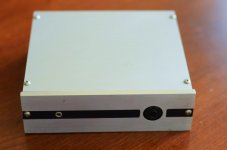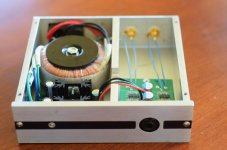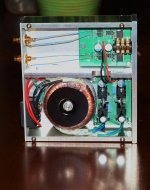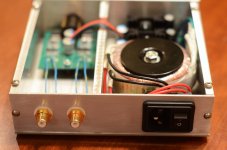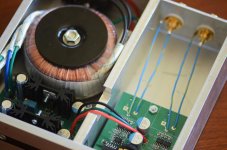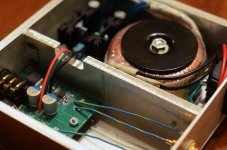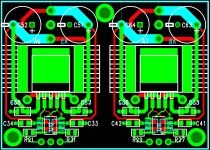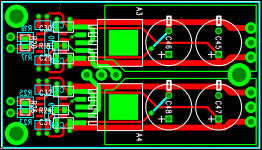Thanks my guess was around 200$ that means i didn't miss any big components.If you can purchase most of the components from the same vendor, or get cheap shipping from ebay sellers, it will cost you around $200 to have a completed amp:
$95 for the kit from Owen
$40 for Misc parts on the BOM not included in the kit
$20 for a small case from Hammond(as an example)
$15 for a nice Alps RK27 Pot.
$20 for shipping (as an example)
$200 total (a very rough total of the top of my head)
Actually they don't in sweden this is a quote from their webpage "OBS: Farnell handlar endast med företag med giltig organisationsnummer, och alla inköp betalas via faktura.". It literally says they only deal with companies with a valid organization number and take payment using invoice only. Really sad because farnell have a wide supply of good components at low prices and a great parameter filter compared to ELFA witch is worse in every aspect here in sweden except that they sell to private persons.I have to disagree with you on your comment about Farnell.
They will sell to anyone, (and so will Elfa). There are lots of DIYers in Europe who use them. You may have to set up an account or a user ID, but you shouldn't have any problems buying from them.
Thanks, but in that case i will go with my DAC707, because this kit doesn't have usb unless i missed some part and my laptop doesn't have spdif. The 707 could probably use a few tweaks as well so it would end up in the same situation. The CS4398 has also got a balanced output so the same mod will be required there.If the ackoDAC is too rich for your blood, this one http://www.diyaudio.com/forums/digi...2496-ak4393-dac-kit-cs8416-ak4393-5532-a.html might be of interest. They discuss the ak4396 based variation of this board, and since the chip itself has balanced outputs, you should be able to bypass the Balanced to SE circuitry and feed a balanced amp directly. With some tweaks, this board looks like a real low budget winner.
I'd be concerned about the amount of current you'd be feeding into the input of the power amp from The Wire. I like to think about a headphone amp in the same way as I think of a poweramp for speakers. It is the source of the current gain needed to drive an transducer(either headphones or speakers). It's better to let a preamp or buffer (like a DCB1) do the job of voltage and impedance control between the source component and the amplifier.
Sorry, my bad. I just finished reading about Owens I/V stage and mixed up the specs for the acko kits... The AKD-26 already have an internal I/V stage and a buffer so i'm happy with that.why do you need anything after the dac to drive the power amp? any decent balanced dac will be able to do that directly, certainly the es9016 will. the aku26 is actually not so badly priced mr slim, its not close to the price of the full blown ackodac and has just about everything built onto the one board, with only a single supply of clean DC required to drive the whole thing. the regulators, hires usb input, mcu with volume and source select and IV stage are all onboard. It has a digital pot, so no need to blow money on a balanced pot and will drive any amp direct with no problem, so no need for a preamp.
Owens I/V stage looks great though, might be worth getting one of those boards for the future in case i get the money for an real ackodac.
A new question, will it be possible to use the BAL-SE version with a SE source and a pot in the middle (with slight modifications)? I know this isn't optimal in any case but this enables me to use my current DAC and buy a pot to get a complete system. And later upgrade to a better balanced DAC and still keep the wire in its intended form for best performance.
Maybe i should just be patient and wait for the final schematics, then it will be easier to know what mods are required...
The main downside of the ESS DACs is their NDA, i would like to see the schematic and datasheet for the device.
I have read about ackos designs and a few of your comments hence my interest. I love the modular design, but the price is a bit hefty for my taste.
The smaller minimized systems on the other hand looks great and would provide a perfect introduction if i want to go big in the future
Hello all,
I haven't posted becuse I'm in Ireland this week, but I wanted to share some pictures of my completed amp.
Just to anticipate some questions:
I went single ended because all my sources are too.
I made the case from aluminum I had so no cost there, just my time.
My meter shows zero dc offset with a source connected, I'll check with a scope when I get back to the states.
Sounds great, absolutely wonderful.
You do not need R2 or R8 for single ended operation.
Again thank you Owen, I'm already considering buying another kit, maybe portable?
-Nelson
I haven't posted becuse I'm in Ireland this week, but I wanted to share some pictures of my completed amp.
Just to anticipate some questions:
I went single ended because all my sources are too.
I made the case from aluminum I had so no cost there, just my time.
My meter shows zero dc offset with a source connected, I'll check with a scope when I get back to the states.
Sounds great, absolutely wonderful.
You do not need R2 or R8 for single ended operation.
Again thank you Owen, I'm already considering buying another kit, maybe portable?
-Nelson
Attachments
....
Actually they don't in sweden this is a quote from their webpage "OBS: Farnell handlar endast med företag med giltig organisationsnummer, och alla inköp betalas via faktura.". It literally says they only deal with companies with a valid organization number and take payment using invoice only. Really sad because farnell have a wide supply of good components at low prices and a great parameter filter compared to ELFA witch is worse in every aspect here in sweden except that they sell to private persons.
.....
Hi,
you might contact this German Farnell representative which sells components to private persons in Germany:
HBE-Shop.de - Your FARNELL-authorized seller
I don't know whether they ship to other countries. At least, they accept PayPal (3% surcharge).
Last edited:
Actually they don't in sweden this is a quote from their webpage "OBS: Farnell handlar endast med företag med giltig organisationsnummer, och alla inköp betalas via faktura.". It literally says they only deal with companies with a valid organization number and take payment using invoice only. Really sad because farnell have a wide supply of good components at low prices and a great parameter filter compared to ELFA witch is worse in every aspect here in sweden except that they sell to private persons.
Another possible way around it - have a look at Borderlinx / DHL:
Welcome to SupplyChainBrain: Borderlinx, DHL Team to Deliver Worldwide Products Bought from U.S. Internet Retailers
https://www.borderlinx.com/m/
their site has an option for Sweden. I hadn't heard of these folks before two weeks ago. I sold something on eBay and stipulated "US customers only, no international". So then a guy from another country wins the auction (aarrgghh), but uses Borderlinx/DHL with a delivery address at a DHL international hub in Lockbourne, Ohio. Looked into it and this an international forwarding service. I ship to the Ohio address and DHL then forwards it to the buyer elsewhere.
Borderlinx is apparently a UK company. Along with buying stuff here (US) and forwarding to Sweden they might have the same thing set up in the UK. If so you could have Farnell ship to the UK address they give you, then DHL sends it along to you for whatever the charge is. Borderlinx advertises the service comes with 30 day store-and-forward, so you can accumulate 30 days of stuff on the US end and then forward it for the one charge. Also keep in mind that DHL has in-house customs. Nothing gets delayed significantly unlike postal mail and ocean shipments. I've shipped a small mountain of parts and equipment from China and other countries via DHL to the US over the past 7 years for the day job. Works great.
Also - as for the BAL-SE running with SE input - just ground one of the balanced inputs and use the other as SE. Opc has run the measurements on that setup in post #106:
http://www.diyaudio.com/forums/head...e-headphone-amplifier-pcbs-3.html#post2426934
He says 2nd and 3rd harmonics are up a bit, but otherwise it rocks.
Last edited:
Hello all,
I haven't posted becuse I'm in Ireland this week, but I wanted to share some pictures of my completed amp.
-Nelson
Looks great Nelson!
A couple of questions. What size transformer did you end up using? Also, did you wire up an LED or such on the power supply? I am curious as to the purpose of the hole on the front left hand side.
Hi Guys,
Well, as usual I'm running behind, but I've been hard at work in the background.
I really wasn't happy with the layouts I finished last week, as I I tried to keep to two layers, and things just weren't quite as nice as I wanted them to be. So I sat down, changed the entire design to three layers, and started over again. I'm glad I did.
I'm finished with the BAL-BAL and SE-SE boards, and I'm nearly finished with the BAL-SE board.
The PSU needs to be re-optimized for three layers, so that should probably take a day or two, but I think I'll be finished by the end of the week.
I've attached a screenshot of both the BAL-BAL version and the SE version as they are now. Here is the clarification for those screen prints:
Layer 1 = green - Analog signal layer
Layer 2 = teal - GND reference layer
Layer 3 = red - Analog signal layer (mostly PSU routing)
The ground pour on layer 2 is not shown, but it will be poured separately for left and right channels with 3 0R resistors to allow the end user to choose where grounds will be tied together (one at input, one at output, and one at PSU).
For the BAL-BAL version, I'm using TO-263 SMD heatsinks to keep thermals under control. Each phase of the output bridge is mirrored on both the front and back of the board, with the front end just below on the top layer. Without the heatsinks, there would not be enough copper plane to keep four output buffers cool enough. The PSU on all boards will be dual mono, with the option of removing some 0R resistors to separate the front end PSU from the buffers. This board is 2.2" x 1.6".
For the SE-SE version, there is plenty of copper so heatsinks are not needed. I really like the way this layout turned out, and at 2.2" x 1.25" it would be a perfect candidate for a portable setup. It gets full dual mono supply options and the same resistor GND selection as the BAL-BAL version.
I've also attached the schematic for all three amps and the PSU. Please feel free to check everything over and let me know if there are any comments, suggestions, or errors.
N-Brock:
That is a VERY nice job you've done with that enclosure! It's exactly how I wanted to do mine, and I really like the layout and dimensions you chose.
If you'd like, I'll send an SE-SE board your way free of charge since you're to first one to post a truly completed project. I really appreciate the feedback, and I know how much work goes into making a finished project like that. Kudos!
Cheers,
Owen
Well, as usual I'm running behind, but I've been hard at work in the background.
I really wasn't happy with the layouts I finished last week, as I I tried to keep to two layers, and things just weren't quite as nice as I wanted them to be. So I sat down, changed the entire design to three layers, and started over again. I'm glad I did.
I'm finished with the BAL-BAL and SE-SE boards, and I'm nearly finished with the BAL-SE board.
The PSU needs to be re-optimized for three layers, so that should probably take a day or two, but I think I'll be finished by the end of the week.
I've attached a screenshot of both the BAL-BAL version and the SE version as they are now. Here is the clarification for those screen prints:
Layer 1 = green - Analog signal layer
Layer 2 = teal - GND reference layer
Layer 3 = red - Analog signal layer (mostly PSU routing)
The ground pour on layer 2 is not shown, but it will be poured separately for left and right channels with 3 0R resistors to allow the end user to choose where grounds will be tied together (one at input, one at output, and one at PSU).
For the BAL-BAL version, I'm using TO-263 SMD heatsinks to keep thermals under control. Each phase of the output bridge is mirrored on both the front and back of the board, with the front end just below on the top layer. Without the heatsinks, there would not be enough copper plane to keep four output buffers cool enough. The PSU on all boards will be dual mono, with the option of removing some 0R resistors to separate the front end PSU from the buffers. This board is 2.2" x 1.6".
For the SE-SE version, there is plenty of copper so heatsinks are not needed. I really like the way this layout turned out, and at 2.2" x 1.25" it would be a perfect candidate for a portable setup. It gets full dual mono supply options and the same resistor GND selection as the BAL-BAL version.
I've also attached the schematic for all three amps and the PSU. Please feel free to check everything over and let me know if there are any comments, suggestions, or errors.
N-Brock:
That is a VERY nice job you've done with that enclosure! It's exactly how I wanted to do mine, and I really like the layout and dimensions you chose.
If you'd like, I'll send an SE-SE board your way free of charge since you're to first one to post a truly completed project. I really appreciate the feedback, and I know how much work goes into making a finished project like that. Kudos!
Cheers,
Owen
Attachments
anybody has compared this amp to any other high end branded amplifier? i'd like to know where this amp stands at the outside world
head to head no not yet, only to other high end diy amps i have here, but i have heard some of the best dynamic amps around and i can tell you this thing, the v1 is u there with amps many times its price, seriously high quality stuff and its hard to even pick holes in it. it loses out a tiny bit in openness to some balanced discrete designs, but speed, preciseness, clarity and bass authority are far from being weaknesses.
someone on head-fi compared it to a headamp gs1 and it came out on top quite easily from memory
it will be put up against some serious competition at the sydney head-fi meet in early July, so there will be some good impressions then
I am looking forward to building this and am happy about the form factor since I will be using it as a portable device (just have to figure out how to recharge the batteries). I do have a questions. The schematic seems to have replaced the LME49600 with RCLAMP0504S which seems to be a "Low Capacitance TVS Array" (a diode array) made by Semetech. Is that correct? Also you originally used LME49990 opamps and said that they were your new favorite opamp. You seem to have switched to the venerable AD797. Did you find that it sounded better in these designs?
Terry
Terry
head to head no not yet, only to other high end diy amps i have here, but i have heard some of the best dynamic amps around and i can tell you this thing, the v1 is u there with amps many times its price, seriously high quality stuff and its hard to even pick holes in it. it loses out a tiny bit in openness to some balanced discrete designs, but speed, preciseness, clarity and bass authority are far from being weaknesses.
someone on head-fi compared it to a headamp gs1 and it came out on top quite easily from memory
it will be put up against some serious competition at the sydney head-fi meet in early July, so there will be some good impressions then
i will be looking forward to the meet report
.I've also attached the schematic for all three amps and the PSU. Please feel free to check everything over and let me know if there are any comments, suggestions, or errors.
Just one. On the power supply I would add the protection diode between the adjust pin and the Vout pin on the regulators, figure 3 pg 10 in the data sheet
http://www.national.com/profile/snip.cgi/openDS=LM317
Officially it shouldn't be necessary according to the sheet, since the output voltage is less than 25V. But I'm kind of a reliability freak and tend to over-engineer these things, especially if it is just the cost of a diode. Having the external adjust capacitor repeatedly discharge through an "internal 50 ohm resistor" just doesn't sound like a happy thing over time.
All in all everything looks excellent! Great work.
Last edited:
i think he probably just didnt have the parts in his library where he was working and so rather than building a new part, used a similar package part for the layout, same with the 49990. they are fairly well interchangeable anyway, each has its peculiarities to get the best out of them, but the basic functionality and spec is the same.
which one are you looking at using portable? the se->se? it'll have to be a decent battery to get any good battery life.
which one are you looking at using portable? the se->se? it'll have to be a decent battery to get any good battery life.
Hi Guys,
Sorry for the confusion on those part numbers in the schematic. As qusp correctly guessed, they are just the generic parts in my library. The BAL-SE and SE-SE uses the LME49600 and LME49990, and the BAL-BAL uses the 49600 and the OPA1632.
agdr:
I can try tossing in a diode and see how it looks. I usually do include them, but like you said, with the lower voltage rails, it's usually not needed.
Thanks for the input!
Cheers,
Owen
Sorry for the confusion on those part numbers in the schematic. As qusp correctly guessed, they are just the generic parts in my library. The BAL-SE and SE-SE uses the LME49600 and LME49990, and the BAL-BAL uses the 49600 and the OPA1632.
agdr:
I can try tossing in a diode and see how it looks. I usually do include them, but like you said, with the lower voltage rails, it's usually not needed.
Thanks for the input!
Cheers,
Owen
Looks great Nelson!
A couple of questions. What size transformer did you end up using? Also, did you wire up an LED or such on the power supply? I am curious as to the purpose of the hole on the front left hand side.
Thanks!
I used a 25VA transformer from antek, but only because their 10VA version was out of stock (and still appears to be).
Yes, the hole on the left is for power indication. I used a small incandecent lamp on the secondary side of the transformer. It shines through some blue plastic on the inside of that hole.
If you'd like, I'll send an SE-SE board your way free of charge since you're to first one to post a truly completed project. I really appreciate the feedback, and I know how much work goes into making a finished project like that. Kudos!
Wow, that's awfully nice of you. Could I buy the components and a PSU kit on top of that? After a bit of thought, I really don't need a portable headamp, but I think I'll try to make my next version as thin as possible. Should be fun.
Thanks,
Nelson
Battery operation should be a piece of cake... I just took a look at the datasheets, and total quiescent current for an SE-SE board at +/-15V would only be about 33mA if you use low BW mode. Driving a low impedance load at very high levels would obviously increase that significantly, but music has a very high crestfactor, and under normal usage it's probably not too much higher than that. I would guess 50mA with decent level into 32ohm phones.
With that in mind, a pair of 1100mAh 4V cell phone batteries would get you upwards of 30 hours of idle time, and probably over 20 hours of play time. Even a pair of 9V batteries would get you close to 4 hours.
I'll be making up an SE-SE board for myself for just this purpose. Is there such a thing as a miniature music player with a really good DAC? Something that could play WAV files off a micro SD card and send them off to an ESS DAC would be pretty sweet!
Cheers,
Owen
With that in mind, a pair of 1100mAh 4V cell phone batteries would get you upwards of 30 hours of idle time, and probably over 20 hours of play time. Even a pair of 9V batteries would get you close to 4 hours.
I'll be making up an SE-SE board for myself for just this purpose. Is there such a thing as a miniature music player with a really good DAC? Something that could play WAV files off a micro SD card and send them off to an ESS DAC would be pretty sweet!
Cheers,
Owen
Is there such a thing as a miniature music player with a really good DAC?
You can always buy a Sandisk Sansa Clip or Clip+. It is said to be very good sounding, and there is an alternative firmware called Rockbox wich has plenty of functions, like gapless flac playback with replay gain and such.
I have a Rockboxed Clip and all I can tell it is fantastic.
You can always buy a Sandisk Sansa Clip or Clip+. It is said to be very good sounding, and there is an alternative firmware called Rockbox wich has plenty of functions, like gapless flac playback with replay gain and such.
I have a Rockboxed Clip and all I can tell it is fantastic.
I picked up four lithium - ion batteries, 4.2VDC, 900mAh (surplus, dirt cheap) which I will probably use. Should give me enough playing time into my phones (32 ohms, Grado).
Owen, I'd like to change my order, if I may, from an SE-SE PCB, to an SE-SE kit.
Thanks for all your work on this.
Terry
Owen, I'd like to change my order, if I may, from an SE-SE PCB, to an SE-SE kit.
Thanks for all your work on this.
Terry
- Home
- Amplifiers
- Headphone Systems
- "The Wire" Ultra-High Performance Headphone Amplifier - PCB's
